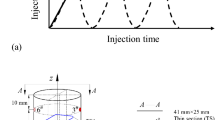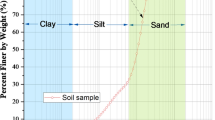Abstract
A series of uniaxial compression experiments were performed on specimens of sandstone containing a pre-existing 3-D surface flaw in various configurations. The influence of the single flaw geometry on the stress–strain response and failure process was recorded and then analyzed in detail including real-time capture of surface cracking process by photographic monitoring. Uniaxial compressive strength drops of 25.7, 33.2 and 21.6 % were observed due to an increase in the flaw length  and flaw depth
and flaw depth  but a decrease in the inclination of the flaw
but a decrease in the inclination of the flaw  . The generation of three typical surface cracking patterns, namely wing cracks, anti-wing cracks and far-field cracks were identified and these depend on the geometry of the pre-existing surface flaw. Wing cracks initiate more readily from longer pre-existing flaws and those of deeper flaw depth or shallower flaw inclination while anti-wing cracks develop in the converse situation. Importantly, the stress required for crack initiation appears to decrease with an increase in flaw depth or a decrease in the flaw inclination. Finally, post-test imaging by X-ray computerized tomography defines the form of internal crack patterns including petal and wing cracks and their interaction and defines the macroscopic ultimate failure modes of the specimens and their dependency on the geometry of the pre-existing flaws. Although specimens containing a penetrating 2-D flaw normally rupture in a tensile splitting mode, those with a non-penetrating 3-D flaw generally fail in a combined shear mode which shows an increased dependency on the petal crack as flaw depth increases.
. The generation of three typical surface cracking patterns, namely wing cracks, anti-wing cracks and far-field cracks were identified and these depend on the geometry of the pre-existing surface flaw. Wing cracks initiate more readily from longer pre-existing flaws and those of deeper flaw depth or shallower flaw inclination while anti-wing cracks develop in the converse situation. Importantly, the stress required for crack initiation appears to decrease with an increase in flaw depth or a decrease in the flaw inclination. Finally, post-test imaging by X-ray computerized tomography defines the form of internal crack patterns including petal and wing cracks and their interaction and defines the macroscopic ultimate failure modes of the specimens and their dependency on the geometry of the pre-existing flaws. Although specimens containing a penetrating 2-D flaw normally rupture in a tensile splitting mode, those with a non-penetrating 3-D flaw generally fail in a combined shear mode which shows an increased dependency on the petal crack as flaw depth increases.














Similar content being viewed by others
References
Bobet A, Einstein H (1998) Fracture coalescence in rock-type materials under uniaxial and biaxial compression. Int J Rock Mech Min 35:863–888
Cannon N, Schulson E, Smith TR, Frost H (1990) Wing cracks and brittle compressive fracture. Acta Metall Mater 38:1955–1962
Chau K et al (2004) Three-dimensional surface cracking and faulting in Dangan islands area, South of Hong Kong. In: Proceedings of third international conference on continental earthquakes, Beijing, China, pp 12–14
Dyskin A, Jewell R, Joer H, Sahouryeh E, Ustinov K (1994) Experiments on 3-D crack growth in uniaxial compression. Int J Fract 65:R77–R83
Dyskin AV, Sahouryeh E, Jewell RJ, Joer H, Ustinov KB (2003) Influence of shape and locations of initial 3-D cracks on their growth in uniaxial compression. Eng Fract Mech 70:2115–2136. doi:10.1016/S0013-7944(02)00240-0
Fujii Y, Ishijima Y (2004) Consideration of fracture growth from an inclined slit and inclined initial fracture at the surface of rock and mortar in compression. Int J Rock Mech Min 41:1035–1041. doi:10.1016/j.ijrmms.2004.04.001
Germanovich LN, Dyskin AV (2000) Fracture mechanisms and instability of openings in compression. Int J Rock Mech Min 37:263–284. doi:10.1016/S1365-1609(99)00105-7
Horii H, Nematnasser S (1986) Brittle failure in compression: splitting, faulting and brittle-ductile transition. Philos Trans R Soc Lond 319:337–374. doi:10.1098/rsta.1986.0101
Jing L (2003) A review of techniques, advances and outstanding issues in numerical modelling for rock mechanics and rock engineering. Int J Rock Mech Min 40:283–353. doi:10.1016/s1365-1609(03)00013-3
Li H, Wong LNY (2012) Influence of flaw inclination angle and loading condition on crack initiation and propagation. Int J Solids Struct 49:2482–2499. doi:10.1016/j.ijsolstr.2012.05.012
Li Y, Chen L, Wang Y (2005) Experimental research on pre-cracked marble under compression. Int J Solids Struct 42:2505–2516
Liang ZZ, Xing H, Wang SY, Williams DJ, Tang CA (2012) A three-dimensional numerical investigation of the fracture of rock specimens containing a pre-existing surface flaw. Comput Geotech 45:19–33. doi:10.1016/j.compgeo.2012.04.011
Liu L, Liu P, Wong H, Ma S, Guo Y (2008) Experimental investigation of three-dimensional propagation process from surface fault. Sci China Ser D Earth Sci 51:1426–1435
Murakami Y, Natsume H (2002) Stress singularity at the corner point of 3-D surface crack under mode II loading. JSME Int J Ser A 45:161–169
Peng S, Johnson AM (1972) Crack growth and faulting in cylindrical specimens of Chelmsford granite. Int J Rock Mech Min 9:37–86. doi:10.1016/0148-9062(72)90050-2
Prudencio M, Van Sint Jan M (2007) Strength and failure modes of rock mass models with non-persistent joints. Int J Rock Mech Min 44:890–902. doi:10.1016/j.ijrmms.2007.01.005
Rao Q, Sun Z, Stephansson O, Li C, Stillborg B (2003) Shear fracture (Mode II) of brittle rock. Int J Rock Mech Min 40:355–375
Sahouryeh E, Dyskin AV, Germanovich LN (2002) Crack growth under biaxial compression. Eng Fract Mech 69:2187–2198. doi:10.1016/S0013-7944(02)00015-2
Tang CA, Kou SQ (1998) Crack propagation and coalescence in brittle materials under compression. Eng Fract Mech 61:311–324. doi:10.1016/s0013-7944(98)00067-8
Vasarhelyi B, Bobet A (2000) Modeling of crack initiation, propagation and coalescence in uniaxial compression. Rock Mech Rock Eng 33:119–139
Wong RHC, Chau KT (1998) Crack coalescence in a rock-like material containing two cracks. Int J Rock Mech Min 35:147–164
Wong RHC, Huang ML, Jiao MR, Tang CA, Zhu WS (2004a) The mechanisms of crack propagation from surface 3-D fracture under uniaxial compression. Key Eng Mater 261:219–224
Wong RHC, Law CM, Chau KT, Zhu WS (2004b) Crack propagation from 3-D surface fractures in PMMA and marble specimens under uniaxial compression. Int J Rock Mech Min 41:360. doi:10.1016/j.ijrmms.2003.12.065
Wong RHC, Guo YS, Chau KT, Zhu WS, Li SC (2006) Anti-wing crack study from 3D surface flaw in real rock. In: Proceedings of the 16th European conference on fracture, Alexandroupolis, Greece, pp 825–826
Wong R, Guo Y, Liu L, Liu P, Ma S (2008) Nucleation and growth of anti-wing crack from tips of strike-slip flaw. In: The 42nd US rock mechanics symposium (USRMS). American Rock Mechanics Association, pp 221–321
Yang S, Jing H (2011) Strength failure and crack coalescence behavior of brittle sandstone samples containing a single fissure under uniaxial compression. Int J Fract 168:227–250
Yang S, Jiang Y, Xu W, Chen X (2008) Experimental investigation on strength and failure behavior of pre-cracked marble under conventional triaxial compression. Int J Solids Struct 45:4796–4819
Yang S, Jing H, Wang S (2012) Experimental investigation on the strength, deformability, failure behavior and acoustic emission locations of red sandstone under triaxial compression. Rock Mech Rock Eng 45:583–606
Yang S, Liu X, Jing H (2013) Experimental investigation on fracture coalescence behavior of red sandstone containing two unparallel fissures under uniaxial compression. Int J Rock Mech Min 63:82–92. doi:10.1016/j.ijrmms.2013.06.008
Yin P, Wong RHC, Chau KT (2014) Coalescence of two parallel pre-existing surface cracks in granite. Int J Rock Mech Min 68:66–84
Acknowledgments
Supports from the Fundamental Research Funds for the Central Universities (Grant No. 2014QNB42) and the National Natural Science Foundation of China (NSFC, Grant No. 51404245) are gratefully acknowledged.
Author information
Authors and Affiliations
Corresponding author
Rights and permissions
About this article
Cite this article
Lu, Y., Wang, L. & Elsworth, D. Uniaxial strength and failure in sandstone containing a pre-existing 3-D surface flaw. Int J Fract 194, 59–79 (2015). https://doi.org/10.1007/s10704-015-0032-3
Received:
Accepted:
Published:
Issue Date:
DOI: https://doi.org/10.1007/s10704-015-0032-3




